Nowadays, everything is simpler because you can access free security policy templates without making them in the first place. A security policy letter is a set of documents related to one another. The documents are about the security control description that rules an organization’s behaviors, systems, and activities.
Even though the documents would not show any specific solution for the existing problem, it would help to define the exact condition. It can be used for protecting the company’s assets.
It could also protect a company’s ability to carry out the existing business. Still, the security policy templates that can be accessed online will be much easier for everyone now.
This article will take you through what a security policy document is, the elements it should include, customizing, implementing, and enforcing, additional features to consider, the different types, why it’s a non-negotiable for modern businesses, and how free templates can make your life much easier.
Elements in a Security Policy Template
Below are essential elements that should be included in every security policy template.
Instructions about Sharing and Transmitting Information
What It Is
This section provides guidelines on how employees should share or transmit data and information.
Why It’s Important
Accidental data leaks or wrongful transmission could result in significant security risks or legal issues.
What to Include
- Protocols for email encryption
- Guidelines for file sharing
- Secure methods for transferring sensitive information
Policies about How to Use All Equipment
What It Is
Guidelines on how employees should use company-owned devices, including computers, smartphones, and other gadgets.
Why It’s Important
Improper usage can lead to vulnerabilities like malware or data loss.
What to Include
- Appropriate usage of equipment
- Restrictions on personal use
- Maintenance and security protocols for each type of device
Policies about Using the Wireless Network and the Company’s Network
What It Is
This section lays out the do’s and don’ts when using any form of network, including both wireless and wired networks.
Why It’s Important
Networks are common targets for cyber-attacks. Setting usage policies helps to mitigate these risks.
What to Include
- Password protocols
- VPN requirements
- Firewall settings
- Restrictions on external storage devices
Policies for Limiting Sensitive Software Use
What It Is
Instructions on which software is restricted and how to properly use sensitive or specialized software.
Why It’s Important
Unregulated software can introduce risks like viruses or unauthorized data access.
What to Include
- List of prohibited software
- Authorization procedures for software requests
- Security protocols for using sensitive software
Policies for Supervising the Security
What It Is
Guidelines for monitoring, enforcing, and reviewing security measures within the company.
Why It’s Important
With active supervision, even the best policies can succeed.
What to Include
- Security audits
- Employee training schedules
- Reporting mechanisms for security issues
Information about Security Breaches Policy
What It Is
What steps will the organization take in the event of a security breach?
Why It’s Important
Being prepared can significantly mitigate the damage from any security incidents.
What to Include
- Incident response team details
- Reporting procedures
- Steps for assessing and containing the breach
Information about Policy Implementation in the Most Effective Way
What It Is
It provides a step-by-step guide for effectively implementing your security policy.
Why It’s Important
Even a well-crafted policy is only useful if it’s properly implemented.
What to Include
- Timeline for implementation
- Responsibilities of each department
- Checklist for tracking compliance
Your security policy will be a robust framework that protects your organization while adapting to its unique needs and challenges.
Customizing Your Security Policy Template
Creating a robust security policy is not a one-size-fits-all approach. Every organization has unique challenges, strengths, and areas requiring special focus. That is why customizing your security policy template is crucial. Here’s a closer look at how to do it effectively.
Choosing the Right Template
It’s crucial to pick one that best aligns with your organization’s needs.
Making Adjustments to the Template
After you’ve selected a template, don’t hesitate to make adjustments so it perfectly matches your company’s unique needs.
Customization is key; therefore, take the time to modify clauses, add specific guidelines, or remove elements that don’t apply. It’s your responsibility to ensure that the policy fits like a glove.
Checking Compliance
Before finalizing your document, ensuring it complies with all relevant local and federal laws is essential. This step is crucial for avoiding any legal complications down the line.
Make sure to communicate the policy clearly to everyone in the organization. Double-check that all employees understand and agree to comply with what’s outlined in the document. It ensures a uniform approach to security across your company.
Implementing and Enforcing Your Security Policy
Introducing the Policy
Once you’ve created your security policy, the next step is to share and introduce it with your team. Explain why it is important and how it will protect the company and its employees.
Tips for Introducing the Policy
- Use simple language that everyone can understand.
- Be open to questions and provide clear answers.
- Make sure top-level management is involved in the introduction to emphasize its importance.
Training and Awareness
After introducing the policy, the next step is training. It could involve a series of workshops, online courses, or even one-on-one sessions. The idea is to ensure everyone knows how to follow the new rules.
Tips for Training and Awareness
- Use real-world examples to explain why each policy is crucial.
- Make training interactive to keep employees engaged.
- Regularly assess understanding through quizzes or discussions.
Regular Updates
Security threats evolve, so your policy should, too. Make it a point to review and update your policy regularly. It ensures that your organization stays ahead of any new risks.
Tips for Regular Updates
- Schedule periodic reviews of the policy.
- Update the policy to include new types of risks or threats.
- Re-train employees whenever there are significant changes to the policy.
Additional Features to Consider
As you complete, there are some extra features you should consider. These add more layers of protection and help ensure your organization stays safe.
Data Backup and Transmission
Backing up and transferring data are routine tasks in any organization. However, how you go about these processes can significantly impact your security. Your policy should clearly outline the rules for how much data can be sent and how it should be stored.
Tips:
- Specify the types of data that require backup.
- Use secure methods for data transmission, such as encrypted channels.
- Limit the size of files or data that can be sent over the network to prevent accidental leaks.
Password Policies
Passwords are often the first line of defense. A good security policy should include robust guidelines for creating and managing passwords. It might involve how often passwords must be changed, the complexity required, and who has access to them.
Tips:
- Make sure passwords are complex, including a mix of letters, numbers, and symbols.
- Implement two-factor authentication (2FA) for an added layer of security.
- Regularly review and update password policies to keep up with new security developments.
Free Security Policy Templates
Navigating the world of security policies can be confusing. There are many kinds to consider based on your organization’s specific needs. Here are different types of security policy templates you might find useful:
Information Security Policy Template
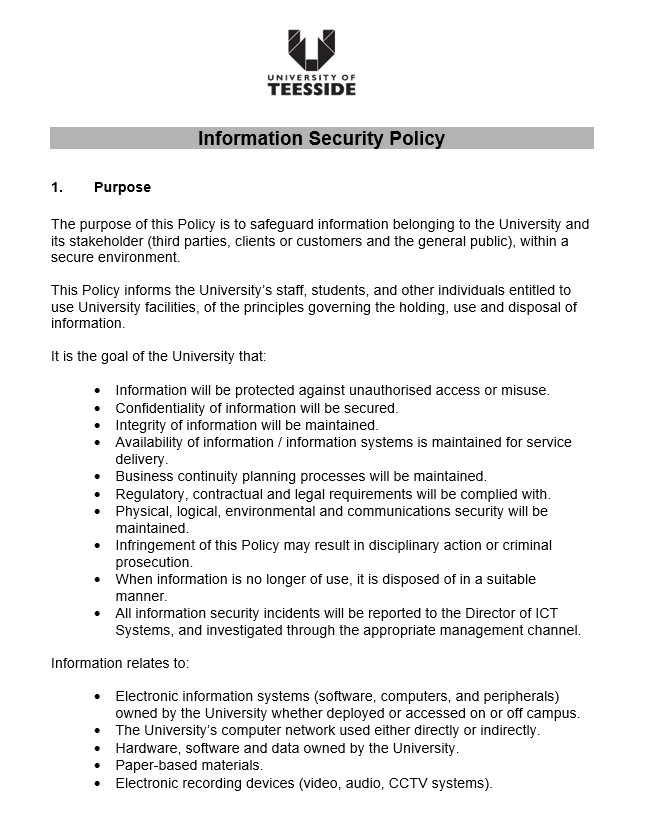
It is all about protecting many kinds of information, like emails and passwords. It helps you know how to keep things secret and safe.
Data Security Policy Template
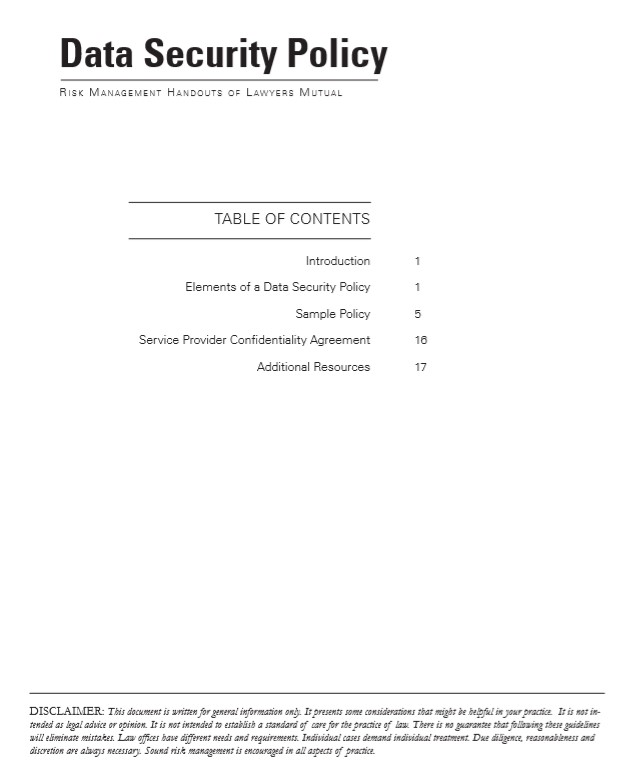
Use this to protect your stored data. It discusses securing important files and documents so that only the right people can see them.
Network Security Policy Template
This one focuses on making sure your internet and company network are safe. It has rules for how to use WiFi and how to share files.
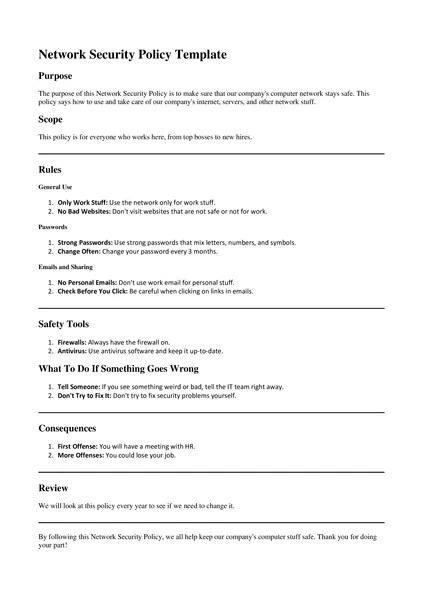
Corporate Security Policy Template
It is a set of rules created for larger groups and protects everyone and everything in the company.
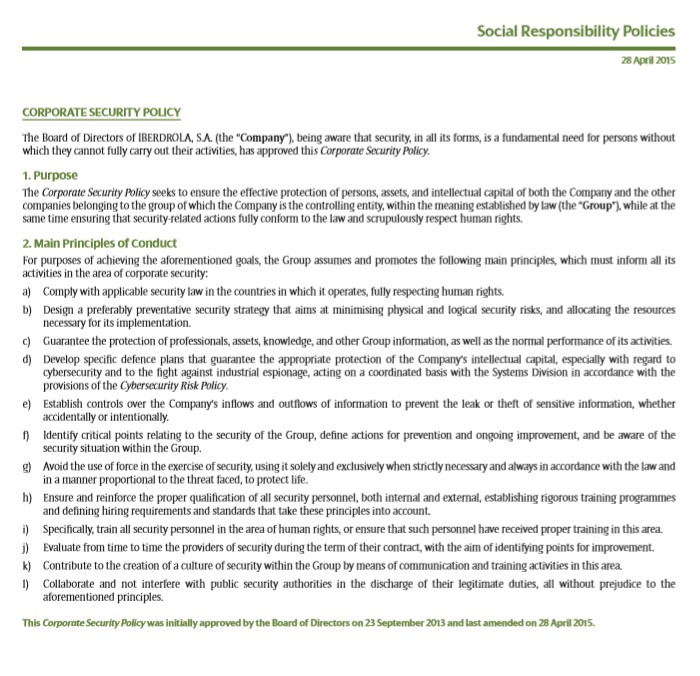
Audit Policy Template
It is all about checking and helps you learn how to check all your security criteria to ensure they function just right.
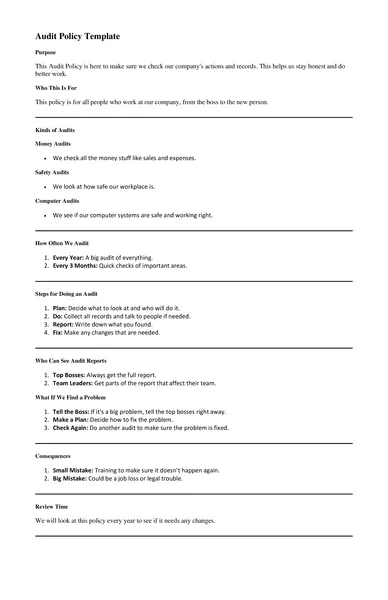
Acceptable Use Policy Template
It tells everyone what they can and can’t do with company resources. It helps people know what is OK to do on company computers and what’s not.
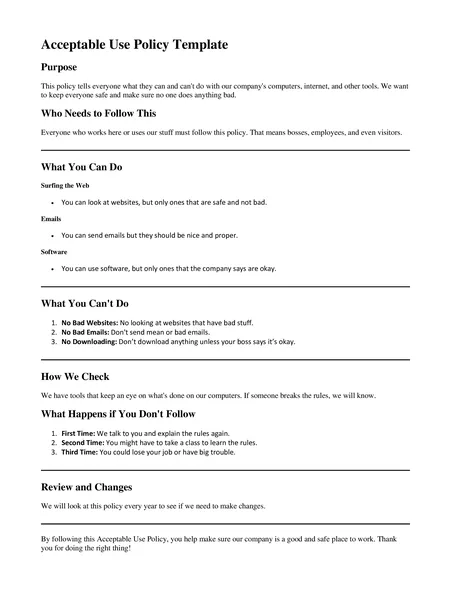
Asset Management Policy Template
It helps you keep track of things like laptops and software. It shows how to make sure everything is recovered and recovered.
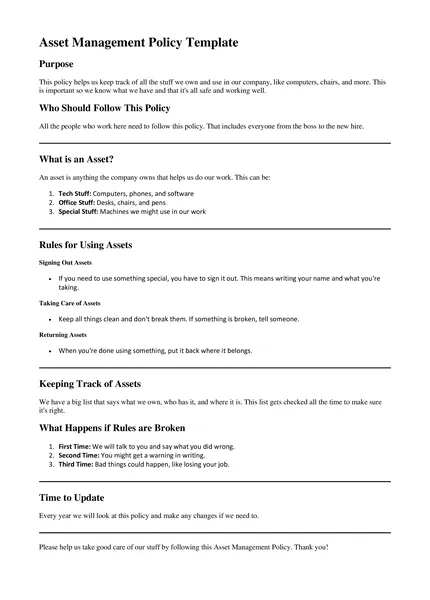
Awareness Training Policy Template
This one is about teaching and illustrates ensuring everyone knows how to stay secure while accomplishing the job.
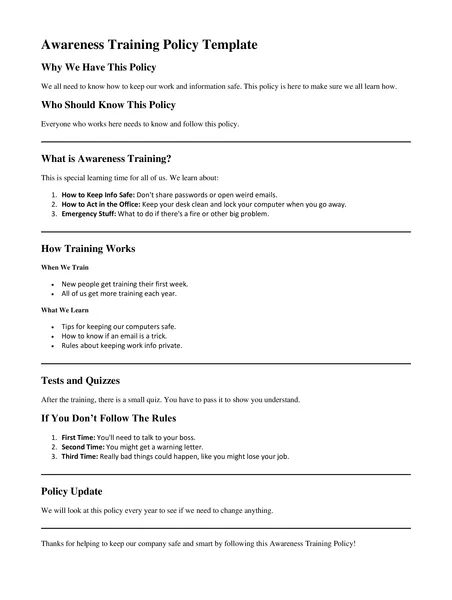
Business Continuity Policy Template
It is your guide for what to do if something big happens, like a power cut. It helps you keep going and keep everything safe.
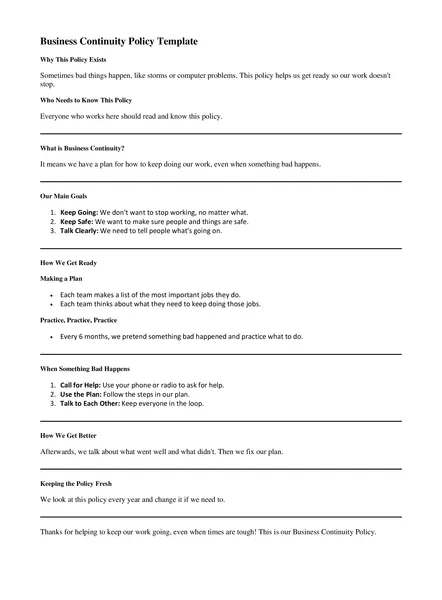
Change Management Policy Template
This one tells you the steps to take when making any changes in the company. It helps keep everything smooth and secure.
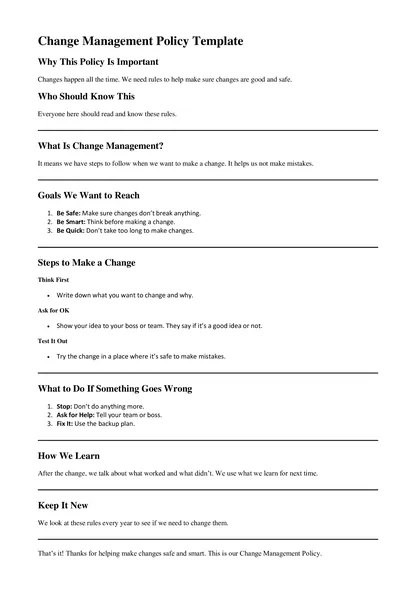
Encryption Policy Template
This talks about making your data unreadable to others. It is good for when you need to send secret things over the Internet.
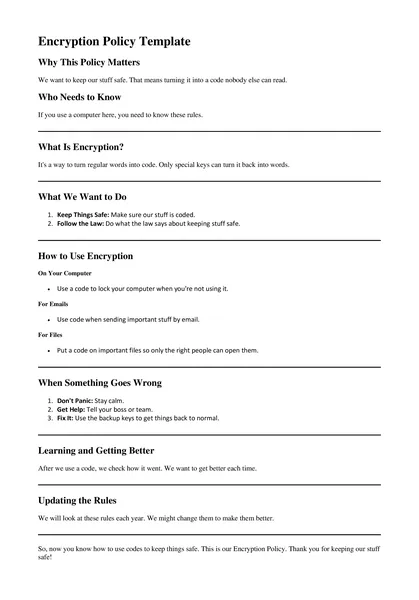
IAM Policy Template (Identity and Access Management)
It helps you understand who has the right to do specific things. It’s about giving the right people access to the right info.
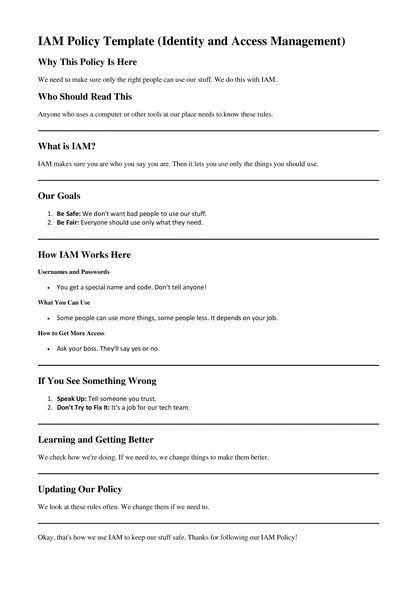
Incident Response Policy Template
It is your go-to guide for what to do if something bad happens. It helps you act fast to make things safe again.
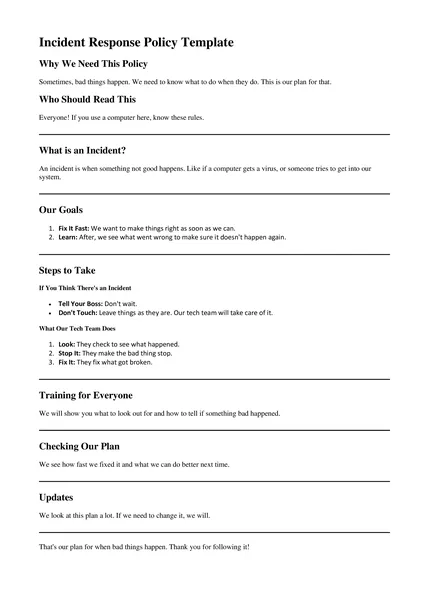
Information Classification Policy Template
This one helps you sort your information. It tells you what information is secret and what is not so you can keep it safe correctly.
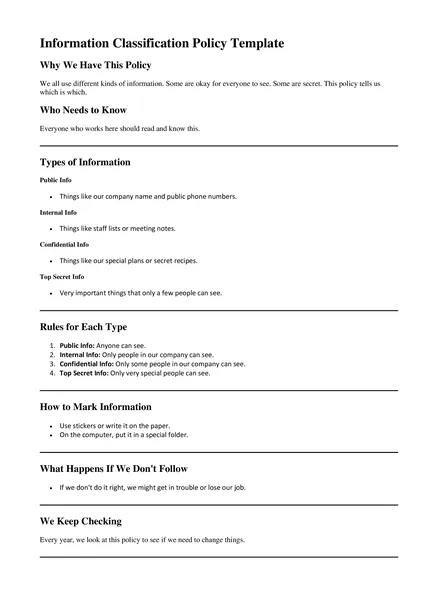
Security Definitions: Appendix A
This part is like a small dictionary. It explains all the special words about security you need to know.
Network Management Policy Template
It is all about managing your internet and network. It helps make sure all the connections are safe and sound.
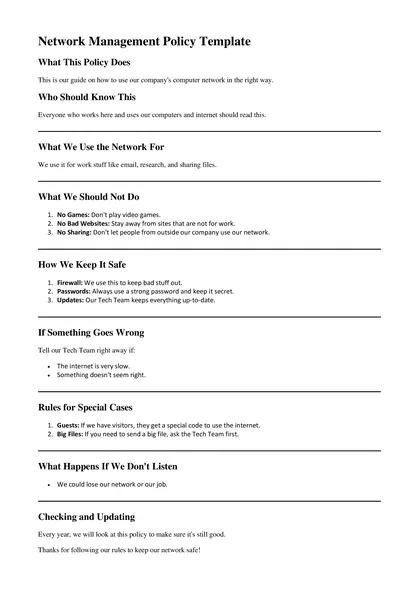
PCI Policy Template (Payment Card Industry)
It is very important if you deal with credit cards. It tells you how to keep all that payment information secure.
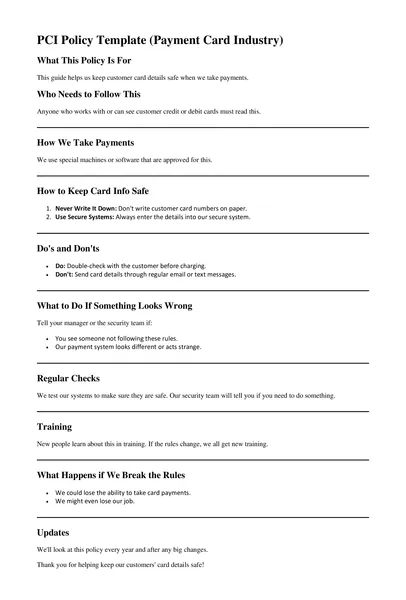
Physical Security Policy Template
It helps you keep the actual building and the stuff in it safe. It’s good for knowing what locks to use and where cameras should go.
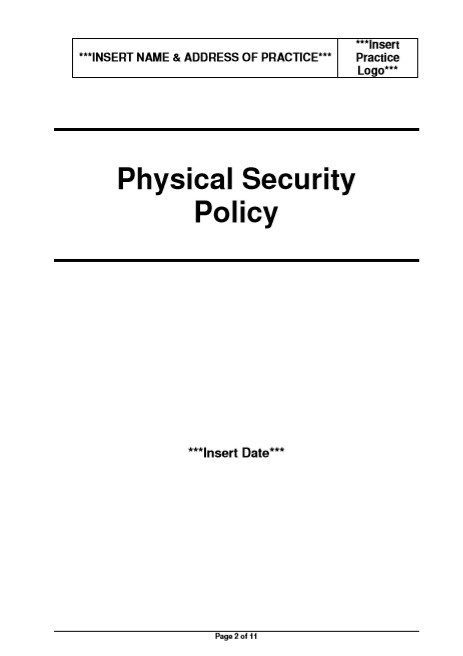
Remote Work Policy Template
This one helps people who work away from the office. It shows how to stay secure while working from home or in a caffe.
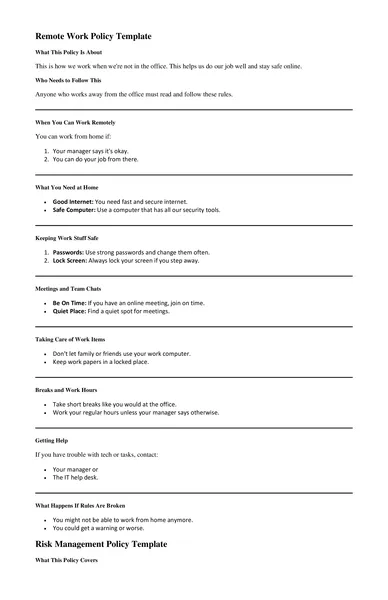
Risk Management Policy Template
This template helps you think about what bad things could happen. It helps you plan so those bad things are less likely to happen.
System Development Policy Template
It is all about making or buying new computer systems. It assists you in understanding what to examine to ensure it’s safe.
Vendor Management Policy Template
This one tells you how to deal with other companies you buy from. It makes sure those relationships are safe and fair.
Vulnerability Management Policy Template
It helps you find weak spots in your security. Once you know, you can fix them to make everything even safer.
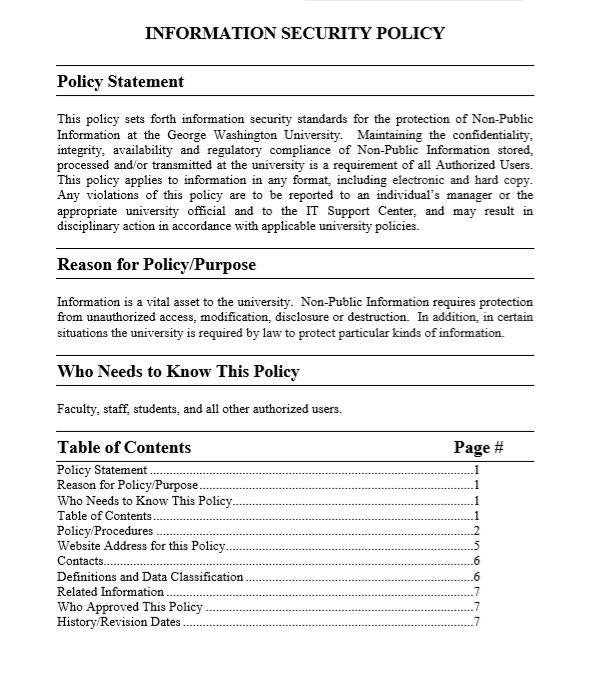
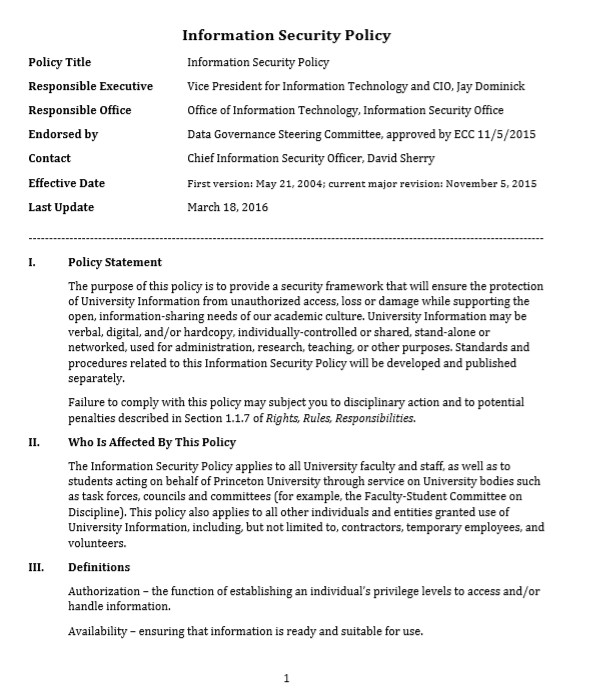
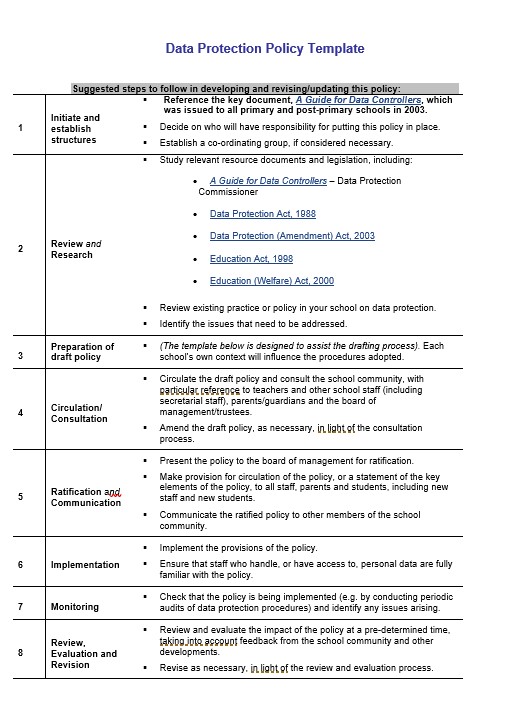
Conclusion
You need to choose the right template according to the purpose of your document. Do not hesitate and feel tired of adjusting the template so it matches your company’s needs.
Also, check if everyone in the company or organization complies with things you have written on the security policy templates.
Understand security policy in an organization and how free templates can help. So why wait? Start safeguarding your company today!
Additional Resources
- [Free Security Policy Templates]
- [Recommended Reading]
- [Online Tutorials]
FAQs:
What is a Security Policy Template?
It is a ready-to-use guide that helps you set up rules to keep your company safe. It’s like a helper for making your safety plan.
Do I need different templates for different parts of my company?
Yes, you may need different templates for data, the internet, and even the building. Each template focuses on a special part of security.
How do I choose the right template?
Pick a template that matches what you need to protect. For example, if you need to keep your online data safe, pick a Network Security Policy Template.
Can I change the template?
Yes, you can! Feel free to change the template to fit your company’s special needs.
Do these templates meet legal requirements?
Each template is a good starting point, but you need to make sure it fits with your local and country laws. It’s good to ask a legal helper for advice.
How often should I update my security policy?
You should often review and change your policy to keep up with new safety things. At least once a year is a good rule.
What should I do if something bad happens?
Each policy has a part about what to do in an emergency. It will guide you on steps to take to make things safe again.
Can I use these templates for a small business?
Yes, these templates work for both big and small businesses. Just pick the one that fits your needs the best.
What do I do after I pick a template?
After you pick a template, the next step is to fill it out and share it with your team. You should train on the new rules too.
Are these templates costly?
Many templates are free or low-cost. But remember, keeping your company safe is worth it, so sometimes spending a little is a good idea.

The content creator team at calipsotree.com is dedicated to making topics accessible to everyone, with over 9 years of experience in writing and breaking down complex concepts into easy-to-understand articles that answer readers’ financial questions.








